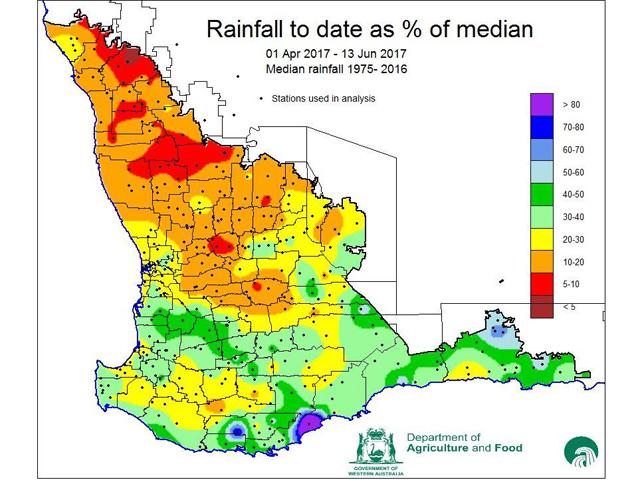Department helps agricultural businesses to navigate 2017 season
Department officers throughout the grainbelt and adjacent areas are working to support agricultural businesses affected by below average rainfall.
While good levels of stored summer soil moisture has been topped up by autumn rains on the south coast and parts of the Great Southern, areas in the northern and north-eastern agricultural area and the lower Great Southern are experiencing well below average rainfall.
The department’s Statistical Seasonal Forecasting (SSF) system's June seasonal outlook predicts below average rainfall for the majority of the South West Land Division for winter and spring.
The SSF indicates a 0-40% chance of exceeding median rainfall from June to August for the majority of the grainbelt, in the decile 2-3 range, based on a poor to good predictive skill, with the exception of Ravensthorpe and the western part of the Esperance Shire, which has a higher chance of 40-60% of exceeding average rainfall, in the likely 4-7 decile range.
The longer term outlook for June to October is also for a 0-40% chance of exceeding median rainfall, in the 2-3 decile range, across the majority of the South West Land Division, based on a 50-75% consistent predictive skill.
Department officers from across the grainbelt are liaising with local grower groups, consultants and farming organisations to ensure agribusinesses receive the support they require.
A Season 2017 webpage is available on the department’s website that harnesses a vast range of information to assist landholders to navigate the season ahead.
It includes useful information on crop agronomy, livestock management, farm budgeting and health and financial information.
Climate and weather tools
The department’s website has several climate and weather tools to assist decision making, including:
- Weather stations - real time data form more than 170 weather stations around the State, including weather summaries, charts and Doppler radar rainfall and wind images
- Seasonal climate information - including rainfall forecasts, plant available soil moisture maps, potential yield calculator and frost risk maps
- Rainfall to date tool - graphs tailored to location
- Soil water tool – graphs showing soil water accumulation
- Potential yield tool - calculates potential wheat yield to location
- Extreme weather events tool – maps real time information about frost and heat events.
Cropping
The below average rainfall conditions have already had an impact on cropping programs and many grain growers are modifying their plans to optimise crop potential.
The department has undertaken modelling to identify likely impact from delayed emergence of from wheat and canola crops so growers can evaluate whether other options need to be considered for these paddocks.
There has also been research on the value of reseeding canola crops.
In addition work has been done on breakeven yeilds for wheat and canola.
Livestock
The department has been monitoring the situation to assist livestock producers to make informed decisions about feed budgeting, stocking rates and opportunities to capitalise on solid market conditions.
Livestock feeding has been a priority, with Pastures from Space observations showing low amounts of Food on Offer (FOO), across much of the grain belt.
Many livestock producers have already commenced supplementary feeding and feed budgeting will be essential if dry conditions persist in coming months.
The department has a number of tools and calculators to assist sheep grazing management.
Department officers report livestock across the regions are currently in good condition.
Support Services
It seems likely that 2017 will be a variable season for much of the grainbelt.
Good communication and social support will be essential to help each other through the months ahead.
Services are available to assist people through this difficult period:
- WA rural health, financial and information support directory
- Rural Financial Counselling Service WA or freecall 1800 612 044 - free financial counselling services to assist primary producers
- Regional Men’s Health Initiative or call (08) 96902277
- Farm Household Allowance or call 13 23 16 – a household support payment from the Australian Government
- Farm Business Training or 1800 198 231 – targeted training to improve business management provided via the department.
The Season 2017 webpage will be updated with relevant, useful information as the season progresses.

